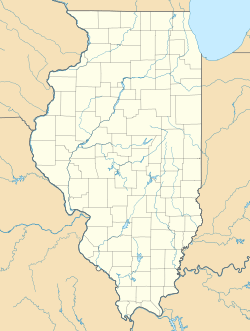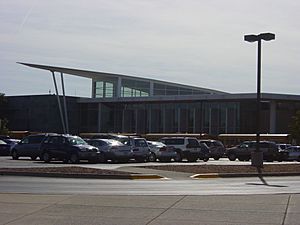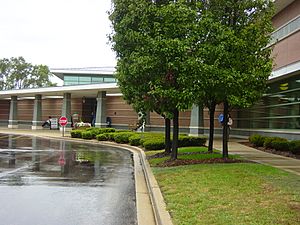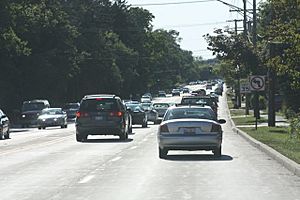Lincolnshire, Illinois facts for kids
Quick facts for kids
Lincolnshire, Illinois
|
|
|---|---|
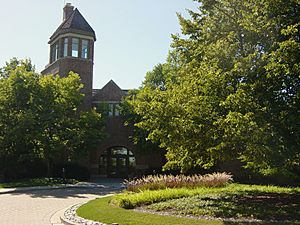
Lincolnshire Village Hall
|
|
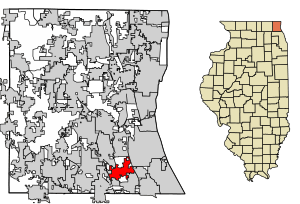
Location of Lincolnshire in Lake County, Illinois.
|
|
| Country | United States |
| State | Illinois |
| County | Lake |
| Township | Vernon, West Deerfield |
| Founded | 1957 |
| Government | |
| • Type | Council-Manager form, Home rule municipality |
| Area | |
| • Total | 4.70 sq mi (12.16 km2) |
| • Land | 4.56 sq mi (11.80 km2) |
| • Water | 0.14 sq mi (0.36 km2) |
| Population
(2020)
|
|
| • Total | 7,940 |
| • Density | 1,742.37/sq mi (672.68/km2) |
| Time zone | UTC-6 (CST) |
| • Summer (DST) | UTC-5 (CDT) |
| ZIP Code(s) |
60069
|
| Area codes | 847 & 224 |
| FIPS code | 17-43666 |
| Wikimedia Commons | Lincolnshire, Illinois |
Lincolnshire is a village in Lake County, Illinois, United States. It's a northern suburb of Chicago. In 2020, about 7,940 people lived there. The village was named after Lincolnshire, England. It became an official village on August 5, 1957. This happened when land was bought to build homes in the Half Day area.
The Des Plaines River flows through the village from north to south. Illinois Route 22 also crosses the village from east to west. Several big companies have their main offices in Lincolnshire. These include Camping World, Quill Corporation, Sysmex America, and Zebra Technologies.
Lincolnshire is home to the public Adlai E. Stevenson High School. This school is part of the Lincolnshire-Prairie View School District 103. The village also has Lincolnshire Commons, which is a fancy shopping area. Lincolnshire has its own police and public works departments. It gets its water from the city of Highland Park, which gets water from nearby Lake Michigan. The village has a council–manager government, meaning a council and a manager run it. The current mayor of Lincolnshire is Elizabeth Brandt.
Contents
Lincolnshire's History
Before the Village Was Formed
The first people to live in the Lincolnshire area were Potawatomi Native Americans. They came from Canada and Wisconsin in the 1500s. They were looking for a warmer place to live. The first Europeans to visit were French explorers Father Jacques Marquette and Louis Jolliet in 1673. They sailed down the Des Plaines River and met the Potawatomi. One Potawatomi village was along the west bank of the Des Plaines River. This was the first real settlement in the area.
The Lincolnshire area was originally part of Half Day. This was the first place settled by non-Native Americans in Lake County. Captain Daniel Wright was the first white settler in Lincolnshire. He arrived in 1834. The Potawatomi were later moved away because of the 1833 Treaty of Chicago.
Half Day grew a lot in the 20 years after Wright arrived. New settlers came, like Seth Washburn, the first postmaster of Vernon Township. Laura Sprague was the first teacher in the area. By 1855, Half Day was a busy community. It had a blacksmith's shop, a sawmill, a country store, and a church. The Chicago and Milwaukee Railway also helped the town grow. When Henry Ford invented the automobile, Half Day became a popular place for fun. Many businesses opened, like an amusement park, a race track, and a bowling alley.
How Lincolnshire Grew
After World War I, wealthy farmers bought land in Vernon Township. Louis Leverone bought the Half Day area. In 1955, he sold land to a developer named Roger Ladd. Ladd's company created a new neighborhood called "Lincolnshire."
Life in the new Lincolnshire was hard at first. The roads were dirt, and there was no good sewer system or natural gas lines. Police help was far away in Waukegan, about 16 miles north. So, the Cambridge Forest Association (CFA) was formed. This group worked to make life better for the people of Lincolnshire. With the CFA's help, Lincolnshire became an official village on August 5, 1957. The CFA later changed its name to the Lincolnshire Community Association.
Lincolnshire's government was careful about growing at first. But later, people who wanted faster growth took charge. They helped bring the Marriott Lincolnshire Resort and the Lincolnshire Corporate Center to the village after 1983. Lincolnshire also tried to add the old Half Day community to its borders. But it lost a court case to the village of Vernon Hills in 1994. This court case set the current border between the two villages.
To manage its new areas, Lincolnshire built a new village hall in 1993. It also created a downtown area with shops and businesses. These included the Lincolnshire Corporate Center, City Park, and the Lincolnshire Commons. These places were built from the mid-1990s to the mid-2000s.
In 2005, Buffalo Grove and Lincolnshire agreed on how to divide the land around the Prairie View area. This land was split equally between the two villages.
Where is Lincolnshire?
Lincolnshire is located at 42°11′47″ North and 87°55′2″ West. It shares borders with several other villages. These include Vernon Hills to the northwest, Buffalo Grove to the southwest, Bannockburn to the east, and Riverwoods to the southeast. The city of Lake Forest is to the northeast. The community of Prairie View is directly to the west.
In 2010, Lincolnshire covered about 4.67 square miles. Most of this (about 98%) is land, and a small part (about 2%) is water.
Lincolnshire is a suburb of Chicago in the southern part of Lake County. It's in the very northeastern part of Illinois. The Des Plaines River flows through the village, dividing it in half. Half Day Road (Illinois Route 22) also splits the village from east to west. Milwaukee Avenue (U.S. Route 45) runs north to south through Lincolnshire.
Lincolnshire has been a Tree City USA every year since 1988. To keep its trees healthy, the village has a "Tree Preservation Ordinance." This law makes it hard to remove trees.
Lincolnshire is on the edge of two watersheds near Chicago. One is for the Des Plaines River, and the other is for the north part of the Chicago River. This is because the Des Plaines River runs through the village.
Weather in Lincolnshire
Lincolnshire's weather is similar to Chicago's. It has a humid continental climate with four clear seasons. Lincolnshire gets about 36.28 inches of precipitation (rain and snow) each year.
| Climate data for Lincolnshire, IL | |||||||||||||
|---|---|---|---|---|---|---|---|---|---|---|---|---|---|
| Month | Jan | Feb | Mar | Apr | May | Jun | Jul | Aug | Sep | Oct | Nov | Dec | Year |
| Mean daily maximum °F (°C) | 30 (−1) |
35 (2) |
45 (7) |
56 (13) |
67 (19) |
78 (26) |
83 (28) |
81 (27) |
75 (24) |
63 (17) |
49 (9) |
36 (2) |
58 (14) |
| Mean daily minimum °F (°C) | 14 (−10) |
18 (−8) |
28 (−2) |
37 (3) |
47 (8) |
56 (13) |
63 (17) |
62 (17) |
54 (12) |
42 (6) |
32 (0) |
20 (−7) |
39 (4) |
| Average precipitation inches (mm) | 1.89 (48) |
1.56 (40) |
2.50 (64) |
3.70 (94) |
3.59 (91) |
3.86 (98) |
3.50 (89) |
4.84 (123) |
3.24 (82) |
2.70 (69) |
3.22 (82) |
2.20 (56) |
36.8 (936) |
| Source: The Weather Channel | |||||||||||||
Who Lives in Lincolnshire?
| Historical population | |||
|---|---|---|---|
| Census | Pop. | %± | |
| 1960 | 555 | — | |
| 1970 | 2,531 | 356.0% | |
| 1980 | 4,151 | 64.0% | |
| 1990 | 4,931 | 18.8% | |
| 2000 | 6,108 | 23.9% | |
| 2010 | 7,275 | 19.1% | |
| 2020 | 7,940 | 9.1% | |
| U.S. Decennial Census 2010 2020 |
|||
Population Changes Over Time
In 2020, the population of Lincolnshire was 7,940 people. Most residents were White (73.24%), followed by Asian (18.35%). About 3.88% of the population was Hispanic or Latino.
| Race / Ethnicity (NH = Non-Hispanic) | Pop 2000 | Pop 2010 | Pop 2020 | % 2000 | % 2010 | % 2020 |
|---|---|---|---|---|---|---|
| White alone (NH) | 5,630 | 6,534 | 5,815 | 92.17% | 89.81% | 73.24% |
| Black or African American alone (NH) | 31 | 60 | 83 | 0.51% | 0.82% | 1.05% |
| Native American or Alaska Native alone (NH) | 2 | 1 | 4 | 0.03% | 0.01% | 0.05% |
| Asian alone (NH) | 227 | 442 | 1,457 | 3.72% | 6.08% | 18.35% |
| Pacific Islander alone (NH) | 4 | 0 | 2 | 0.07% | 0.00% | 0.03% |
| Other race alone (NH) | 8 | 9 | 12 | 0.13% | 0.12% | 0.15% |
| Mixed race or Multiracial (NH) | 53 | 80 | 259 | 0.87% | 1.10% | 3.26% |
| Hispanic or Latino (any race) | 153 | 149 | 308 | 2.50% | 2.05% | 3.88% |
| Total | 6,108 | 7,275 | 7,940 | 100.00% | 100.00% | 100.00% |
In 2010, there were 7,275 people in the village. Most were White (91.5%), and 6.1% were Asian. In 2000, there were 6,108 people and 2,134 households. About 37.4% of households had children under 18. The average household had 2.75 people. The median age in the village was 44 years old.
Fun and Festivals in Lincolnshire
Lincolnshire has an annual summer festival called the Taste of Lincolnshire. It's like a smaller version of the "Taste of Chicago." It offers small samples from local restaurants and has local entertainment. There are musicians, a raffle, and even a pet show.
Since 1993, Lincolnshire has also hosted the Lincolnshire Art Festival. This event happens a few weeks before the Taste of Lincolnshire. It encourages artists from Lake County to show their work. Entertainment and parking are free to attract visitors.
The village also celebrates the Fourth of July with an event called "Red, White, and BOOM!" It includes live music, a raffle, and fireworks at Spring Lake Park.
Famous People from Lincolnshire
Two actors have lived in Lincolnshire. Alison La Placa, known for her role on the TV show Duet, went to Stevenson High School. Kyle Brandt, another Stevenson graduate, played Philip Kiriakis on the soap opera Days of Our Lives. He also appeared on the reality show The Real World: Chicago.
Parks and Play in Lincolnshire
Lincolnshire has nine public parks. Spring Lake Park has a small beach and hosts the Fourth of July celebrations. North Park is a large sports field and nature area. It works with Lincolnshire-Prairie View School District 103 to provide space for youth sports.
School District 103 also worked with the village to create Rivershire Park. This is an educational nature center. It teaches students and visitors about the local plants and animals. Memorial Park is a place for walkers and bikers to rest. Florsheim Nature Preserve has rare plants and protects endangered species. Whytegate Park has sports courts and a fitness course. Balzer Park has a hiking trail and sports facilities. Bicentennial Park and Olde Mill Park are playgrounds for children.
The Lincolnshire Marriott Resort is a large area west of the Des Plaines River. It has an 18-hole golf course that is open to guests and offers lessons to local residents. The resort is also home to the Marriott Theatre. This theater has received many awards for its shows.
Sports Stars and Fun Facts
Four famous athletes have lived in Lincolnshire. Andrea Jaeger, a professional tennis player, graduated from Adlai E. Stevenson High School. Matt O'Dwyer, a former NFL football player, was born in Lincolnshire. Robert Berland, an Olympic medalist in judo, lives in the village. New York Knicks basketball player Jalen Brunson moved to Lincolnshire in 2010 to attend Stevenson High School.
The Stanley Cup, a famous hockey trophy, visited Lincolnshire in October 2013 and again in July 2015.
Schools in Lincolnshire
Lincolnshire has two main school districts: Lincolnshire-Prairie View School District 103 and Adlai E. Stevenson High School District 125. Some students also attend school in Aptakisic-Tripp Community Consolidated School District 102 in nearby Buffalo Grove.
District 103 has three schools: Laura B. Sprague Elementary School (Kindergarten to 2nd grade), Half Day Intermediate School (3rd to 5th grade), and Daniel Wright Junior High School (6th to 8th grade). District 125 only has Adlai E. Stevenson High School. These are all public schools. A small part of Lincolnshire is served by Bannockburn School and Deerfield High School.
The first school in Lincolnshire was Half Day Intermediate School. It started as a one-room schoolhouse. It grew over time but closed in 1983. Its students went to Laura B. Sprague Elementary and Daniel Wright Junior High. However, Half Day School reopened nine years later when the other schools became too full. In 2017, more space was added to Laura Sprague and Half Day schools. Also, 6th grade moved to Half Day from Daniel Wright that year.
Learning Beyond School
Lincolnshire also has other educational places. DeVry University's Keller School of Management has a branch here. The Southlakes Campus of the College of Lake County is just north in Vernon Hills. Students from Stevenson High School can apply to the University of Illinois at a site in Grayslake. The Lincolnshire Community Nursery School, started in 1973, is for preschoolers in eastern Lincolnshire.
The village is also home to the Vernon Area Public Library. This library serves Lincolnshire and parts of Buffalo Grove, Long Grove, and Vernon Hills. The library offers many special events, like book talks and presentations.
Getting Around Lincolnshire
Lincolnshire is located on three main roads: Illinois Route 22 (also called Half Day Road), Milwaukee Avenue (Illinois Route 21/U.S. Route 45), and Aptakisic Road. Aptakisic Road meets Milwaukee Avenue in southern Lincolnshire. The village's eastern border with Bannockburn is at Interstate 94 (part of the Tri-State Tollway). Route 22 crosses the Des Plaines River and goes over Interstate 94.
Lincolnshire has two main bike paths. One runs north-south along Riverwoods Road in the eastern part of the village. The other runs east-west, crossing the Des Plaines River to the village hall. Smaller bike paths connect different neighborhoods.
O'Hare International Airport is about 18 miles southwest of Lincolnshire. You can get there using the Tri-State Tollway. You can also travel by train from the Prairie View station just west of Lincolnshire.
Pace provides bus service. These buses connect Lincolnshire to Vernon Hills, Niles, and other places.
Village Services
The Village of Lincolnshire gets its water from the City of Highland Park. This water comes from Lake Michigan. Lincolnshire also checks public water pumps and water meters at homes.
Lincolnshire has a sanitary sewer system that connects to the Lake County Sewage Treatment Plant. This plant handles wastewater outside the village. Lincolnshire also has storm drains that flow into the Des Plaines River. To keep the river clean, the village has laws against dumping most chemicals into these drains.
The village has a plan to repair city streets. It also offers services to clear leaves in the fall and snow in the winter. For main roads, residents are given bags to clear leaves from their curbs. The village regularly sweeps other streets.
Waste Management, Inc. handles trash disposal for Lincolnshire.
The engineering part of Lincolnshire's Public Works Department takes care of roads and streets. They also inspect buildings, improve neighborhoods, and plan new ones. The department also has plans for what to do if the river floods.
Images for kids
See also
 In Spanish: Lincolnshire (Illinois) para niños
In Spanish: Lincolnshire (Illinois) para niños



